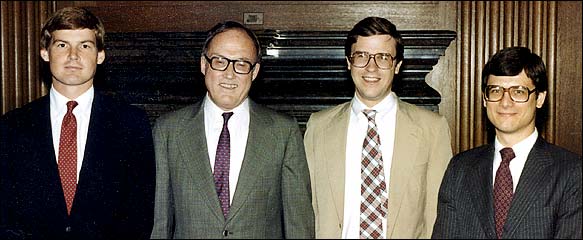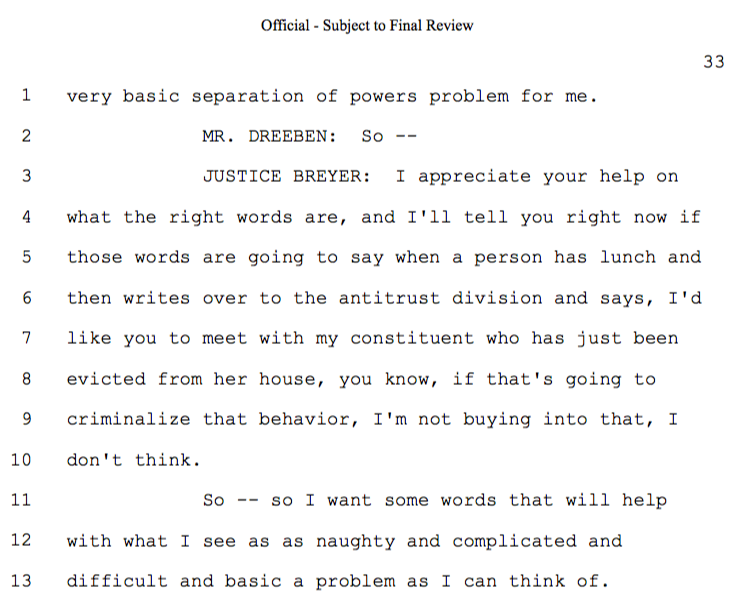In Bank Markazi v. Peterson, the majority opinion by Justice Ginsburg, and the dissent by the Chief, spar over the relevance of Dames & Moore v. Regan. This debate is a particularly entertaining, because Roberts was clerking for Justice Rehnquist during the 8 days in which Dames & Moore was written. (I am willing to guess that at a young JRG had something to do with the opinion).

A young John Roberts is the first from the right.
In her majority opinion, RBG justified Section 8772 based on Dames & Moore:
In furtherance of their authority over the Nation’s foreign relations, Congress and the President have, time and again, as exigencies arose, exercised control over claims against foreign states and the disposition of foreign-state property in the United States. See Dames & Moore v. Regan, 453 U. S. 654, 673–674, 679–681 (1981) (describing this history). In pursuit of foreign policy objectives, the political branches have regulated specific foreign-state assets by, inter alia, blocking them or governing their availability for attachment. See supra, at 3–4 (describing the TWEA and the IEEPA); e.g., Dames & Moore, 453 U. S., at 669–674. Such measures have never been rejected as invasions upon the Article III judicial power. Cf. id., at 674 (Court resists the notion “that the Federal Government as a whole lacked the power” to “nullif[y] . . . attachments and orde[r] the transfer of [foreign-state] assets.”).
The Chief would have none of this, explaining Dames & Moore was limited only to the facts of that case.
The majority suggests that Dames & Moore supports the validity of §8772. But Dames & Moore was self- consciously “a restricted railroad ticket, good for this day and train only.” Smith v. Allwright, 321 U. S. 649, 669 (1944) (Roberts, J., dissenting). The Court stressed in Dames & Moore that it “attempt[ed] to lay down no gen- eral ‘guidelines’ covering other situations not involved here, and attempt[ed] to confine the opinion only to the very questions necessary to [the] decision of the case.” 453 U. S., at 661; see also American Ins. Assn. v. Garamendi, 539 U. S. 396, 438 (2003) (GINSBURG, J., dissenting) (“No- tably, the Court in Dames & Moore was emphatic about the ‘narrowness’ of its decision.”).
Oh, the good ‘ole “restricted railroad ticket” argument. That is, the ruling here only applies to this case, and nothing else. The Court tried a similar approach in Bush v. Gore, explaining that the decision should not be cited in any other contexts.
Our consideration is limited to the present circumstances, for the problem of equal protection in election processes generally presents many complexities.
I have called Bush v. Gore, as well as the cited language in Dames & Moore, an “unprecedent.” Of course, this admonition did not prevent Justice Thomas from citing Bush v. Gore in his solo dissent in Arizona v. Inter Tribal Council of Ariz., Inc. Nor did it prevent RBG from citing Dames & Moore here.
In a footnote, RBG replies to the Chief:
THE CHIEF JUSTICE correctly notes that the Court in Dames & Moore v. Regan, 453 U. S. 654, 661 (1981), urged caution before extending its analysis to “other situations” not presented in that case. Post, at 15. Much of the Court’s cause for concern, however, was the risk that the ruling could be construed as license for the broad exercise of unilateral executive power. See 453 U. S., at 688; American Ins. Assn. v. Garamendi, 539 U. S. 396, 438 (2003) (GINSBURG, J., dissenting). As §8772 is a law passed by Congress and signed by the President, that risk is nonexistent here.
You see what is going on here? Roberts–who very likely wrote at least part of Dames & Moore–is telling everyone that the opinion ought to be read narrowly. Ginsburg–who is now in the majority–assures everyone that the risks young Roberts worried about are not present here–because we are dealing with a statute, rather than a unilateral executive action– so the Court can rely on Dames & Moore.
Roberts, in defense of the precedent he worked on three decades ago, marshals several more distinguishing points:
There are, moreover, several important differences between Dames & Moore and this case. For starters, the executive action Dames & Moore upheld did not dictate how particular claims were to be resolved, but simply required such claims to be submitted to a different tribu- nal. 453 U. S., at 660. Furthermore, Dames & Moore sanctioned that action based on the political branches’ “longstanding” practice of “settl[ing] the claims of [U. S.] nationals against foreign countries” by treaty or executive agreement. Id., at 679.
Roberts also argues that this statute amounts to “commandeering the courts.”
By contrast, no comparable history sustains Congress’s action here, which seeks to provide relief to respondents not by transferring their claims in a manner only the political branches could do, but by commandeering the courts to make a political judgment look like a judicial one. See Medellín v. Texas, 552 U. S. 491, 531 (2008) (refusing to extend the President’s claims- settlement authority beyond the “narrow set of circum- stances” defined by the “‘systematic, unbroken, executive practice, long pursued to the knowledge of the Congress and never before questioned’” (quoting Dames & Moore, 453 U. S., at 686)).
This is a phrase I developed in my article, State Judicial Sovereignty, where I discussed the commandeering of the state courts. Here, Roberts extends it to the commandeering of the federal courts.
A fascinating back-and-forth over an opinion Roberts no doubt takes pride in.

